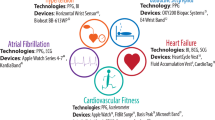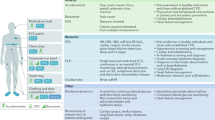Abstract
Purpose of Review
We sought to describe current issues in patient healthcare access to diagnostics and potential solutions via wearable and/or mobile/digital technologies.
Recent Findings
There are ongoing as well as completed studies showing feasibility of direct-to-consumer FDA-approved technologies to identify acute coronary syndromes and/or arrhythmias.
Summary
Improvement in direct-to-consumer technology, cloud-based services, and access to the internet have the potential to greatly benefit and impact patient engagement and access to healthcare as well as early diagnosis of cardiovascular-related diseases.

Similar content being viewed by others
References
Papers of particular interest, published recently, have been highlighted as: • Of importance •• Of major importance
Mobile Fact Sheet. Fact sheets. Internet & Tech: Pew Research Center, 2018.
2016 Broadband progress report. Federal Communications Commission, 2018.
Pitts SR, Niska RW, Xu J, Burt CW. National Hospital Ambulatory Medical Care Survey: 2006 Emergency department summary. Natl Health Stat Report. 2008:1–38.
Lee TH, Goldman L. Evaluation of the patient with acute chest pain. N Engl J Med. 2000;342:1187–95.
Chareonthaitawee P, Gibbons RJ, Roberts RS, Christian TF, Burns R, Yusuf S. The impact of time to thrombolytic treatment on outcome in patients with acute myocardial infarction. For the CORE investigators (Collaborative Organisation for RheothRx Evaluation). Heart. 2000;84:142–8.
McNamara RL, Herrin J, Wang Y, et al. Impact of delay in door-to-needle time on mortality in patients with ST-segment elevation myocardial infarction. Am J Cardiol. 2007;100:1227–32.
Gara PT, Kushner FG, Ascheim DD, et al. 2013 ACCF/AHA guideline for the management of ST-elevation myocardial infarction. J Am Coll Cardiol. 2013;61:e78. e140
Krumholz HM, Herrin J, Miller LE, et al. Improvements in door-to-balloon time in the United States, 2005 to 2010. Circulation. 2011;
Yeh RW, Sidney S, Chandra M, Sorel M, Selby JV, Go AS. Population trends in the incidence and outcomes of acute myocardial infarction. N Engl J Med. 2010;362:2155–65.
Probst MA, Mower WR, Kanzaria H, Hoffman JR, Buch EF, Sun BC. Analysis of emergency department visits for palpitations (from the National Hospital Ambulatory Medical Care Survey). Am J Cardiol. 2014;113:1685–90.
Benjamin EJ, Virani SS, Callaway CW, Chamberlain AM, Chang AR, Cheng S, et al. Heart disease and stroke statistics—2018 update: a report from the American Heart Association. Circulation. 2018;137:e67. e492
• Muhlestein JB, Le V, Albert D, et al. Smartphone ECG for evaluation of STEMI: results of the ST LEUIS Pilot Study. J Electrocardiol. 2015;48:249–59. The initial pilot study for the ST LEUIS trial demonstrated the ability to move forward with a prospective trial to compare iPhone-based EKG vs a standard 12-lead EKG in patients where STEMI protocols have been activated.
•• Barbagelata A, Bethea CF, Severance HW, et al. Smartphone ECG for evaluation of ST-segment elevation myocardial infarction (STEMI): design of the ST LEUIS International Multicenter Study. J Electrocardiol. 2017; The ST LEUIS design paper provides the necessary background for the prospective trial comparing first, STEMI EKGs obtained by iPhone vs standard 12-lead and second, to compare STEMI vs ED chest pain for control EKGs.
Olsson T, Terent A, Lind L. Rapid emergency medicine score: a new prognostic tool for in-hospital mortality in nonsurgical emergency department patients. J Intern Med. 2004;255:579–87.
Mehmood T, Al Shehrani MS, Ahmad M. Acute coronary syndrome risk prediction of rapid emergency medicine scoring system in acute chest pain: an observational study of patients presenting with chest pain in the emergency department in Central Saudi Arabia. Saudi Med J. 2017;38:900–4.
Alboni P, Botto GL, Baldi N, Luzi M, Russo V, Gianfranchi L, et al. Outpatient treatment of recent-onset atrial fibrillation with the “pill-in-the-pocket” approach. N Engl J Med. 2004;351:2384–91.
Ben Freedman SS, Lowres N. Asymptomatic atrial fibrillation: the case for screening to prevent stroke. JAMA. 2015;314:1911–2.
Steinhubl SR, Waalen J, Edwards AM, Ariniello LM, Mehta RR, Ebner GS, et al. Effect of a home-based wearable continuous ecg monitoring patch on detection of undiagnosed atrial fibrillation: the mstops randomized clinical trial. JAMA. 2018;320:146–55.
Tison GH, Sanchez JM, Ballinger B, Singh A, Olgin JE, Pletcher MJ, et al. Passive detection of atrial fibrillation using a commercially available smartwatch. JAMA Cardiology. 2018;3:409–16.
Author information
Authors and Affiliations
Corresponding author
Ethics declarations
Conflict of Interest
Joseph B. Muhlestein and Viet T. Le declare that they have no conflict of interest.
Human and Animal Rights and Informed Consent
This article does not contain any studies with animal subjects performed by any of the authors.
Additional information
This article is part of the Topical Collection on Arrhythmias
Rights and permissions
About this article
Cite this article
Le, V.T., Muhlestein, J.B. Use of Wearable Technologies for Early Diagnosis and Management of Acute Coronary Syndromes and Arrhythmias. Curr Cardiovasc Risk Rep 12, 24 (2018). https://doi.org/10.1007/s12170-018-0588-3
Published:
DOI: https://doi.org/10.1007/s12170-018-0588-3




